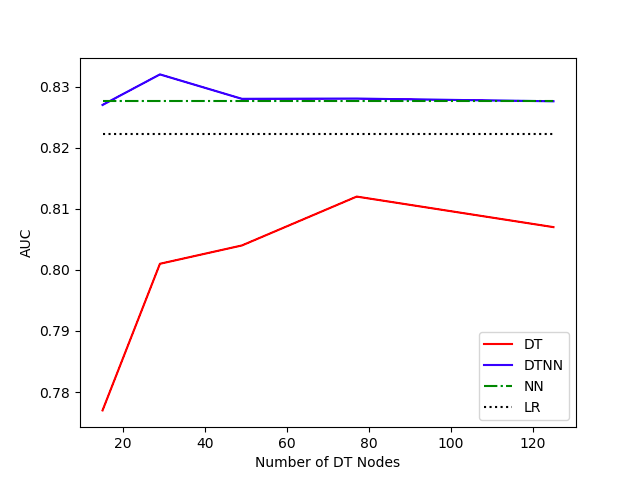Interpretable Post-Transplant Graft Failure Prediction Using Decision Tree Neural Networks
1Georgia Institute of Technology, Atlanta, GA, 2Emory University, Atlanta, GA, 3University of Michigan, Ann Arbor, MI
Meeting: 2019 American Transplant Congress
Abstract number: C132
Keywords: Graft failure, Kidney transplantation, Methodology, Prediction models
Session Information
Session Name: Poster Session C: Kidney Technical
Session Type: Poster Session
Date: Monday, June 3, 2019
Session Time: 6:00pm-7:00pm
 Presentation Time: 6:00pm-7:00pm
Presentation Time: 6:00pm-7:00pm
Location: Hall C & D
*Purpose: Various predictive models identify kidney transplant (KTx) recipients at high risk of graft failure (GF), but comparisons across statistical approaches for a full range of predictors remain inconsistent. Neural Networks (NNs) demonstrate promising accuracy for KTx GF prediction in some studies but lack interpretability, while classical interpretable models such as Logistic Regression (LR) or Decision Trees (DTs) tend to have lower accuracy. We used a broad range of demographic, medical, and socioeconomic (SES) predictors from a large KTx dataset to compare Decision Tree Neural Networks (DTNNs), which combine high accuracy with interpretability, with conventional approaches (LR, DT, NN) for GF prediction.
*Methods: We built models with adult KTx patients (N=35,397 [3,679 GFs]) from 2005-2014 in the US Renal Data System database (primary Medicare coverage before KTx, followed through 2015) merged with US Census data for predicting 1-year GF or death after KTx.
*Results: Predictive accuracy (AUC) was 0.822 for LR, 0.812 for DT, 0.828 for NN, and 0.832 for DTNN. In this sample, DTNNs performed similar to NNs and LRs but higher than DTs, especially for DTs with low complexity (see Fig. 1). Fig. 2 graphically represents how 7 diverse factors for a DTNN contribute to GF risk probability (0 = graft success, 1 = graft failure) and relative importance of factors based on their location.
Figure 1. Performance (AUC) by Model Complexity (Number of nodes in DT) for GF Models
Figure 2. DT for DTNN GF Model
*Conclusions: DTNNs predict KTx GF with high accuracy, which remains high in compact, explainable models with fewer features. These results suggest that predictive models for KTx GF like DTNNs improve upon conventional approaches, maximizing performance and interpretability to enhance clinical usefulness.
To cite this abstract in AMA style:
Valdez JN, Fu T, Hogan J, Adhikary S, Arenson M, Zhang R, Zhang X, Li K, Adams AB, Patzer RE, Sun J. Interpretable Post-Transplant Graft Failure Prediction Using Decision Tree Neural Networks [abstract]. Am J Transplant. 2019; 19 (suppl 3). https://atcmeetingabstracts.com/abstract/interpretable-post-transplant-graft-failure-prediction-using-decision-tree-neural-networks/. Accessed December 14, 2025.« Back to 2019 American Transplant Congress


